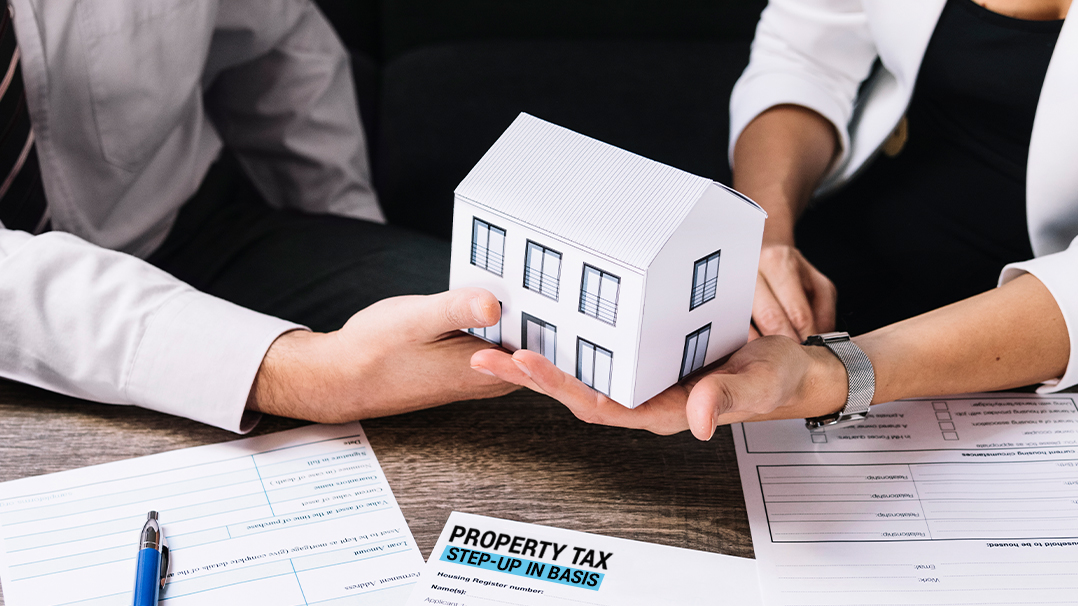
What is a Step-Up in Basis and Does It Apply in San Diego?
April 28, 2023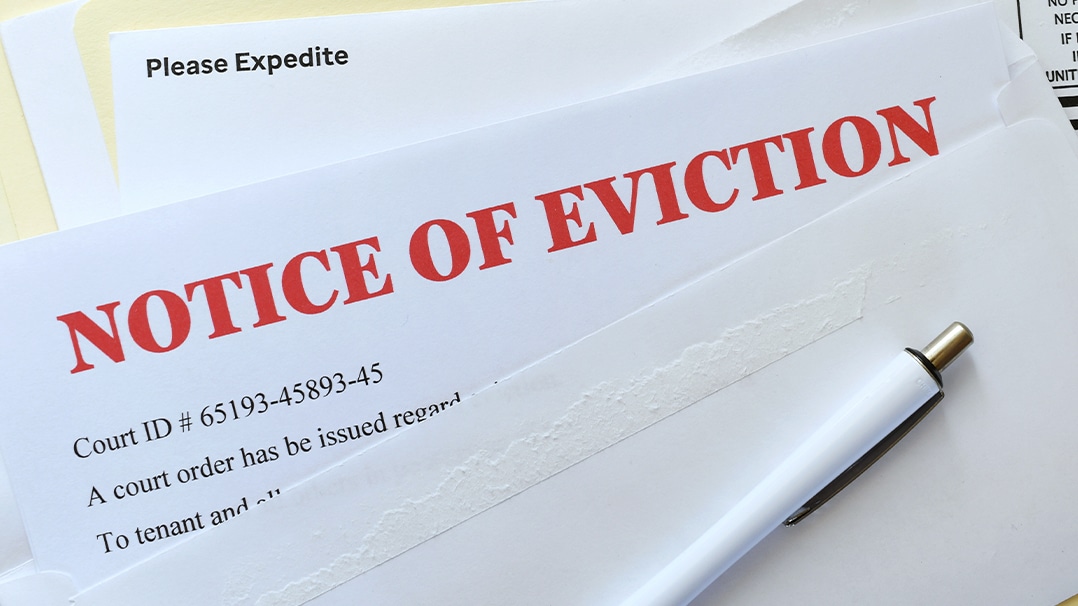
Understanding San Diego’s New Tenant Protection Ordinance
May 12, 2023
Disclaimer: I am not an attorney and this article is not intended as a substitute for advice from the appropriate legal, zoning, financial, construction and/or tax professionals. This information is provided for educational purposes only and is made without warranties or representations
Property taxes are often a significant expense for homeowners, real estate investors, and corporations that own their own facilities. It’s a big enough expense that it’s worth knowing everything there is to know about it, and proper forecasting can be critical to finances throughout the year.
How San Diego Property Taxes Work
One of the most challenging aspects of property taxes is that they’re assessed on the city or county level, so even if you’ve owned property elsewhere in the country, you may not know everything you need to know for local property taxes in the San Diego area.
So, here’s a refresher on what you need to know for both California in general and San Diego specifically.
First, property taxes are assessed every year, but the calculations that determine how much you pay are not repeated annually. A property tax calculation only occurs when ownership of the property changes (except inheritance, which you can read more about here) or when a new building is constructed.
When a new value assessment is required, an auditor or assessor will evaluate the property, come up with its value, and apply adjustments as needed. From there, the value is passed to the county controller, who uses the proper tax rate for that value and issues you a tax bill to pay.

Property taxes are calculated using two figures: the value of the property and the effective tax rate.
In California, under Proposition 13, the value is only assessed under a change of ownership. That means the longer you hold a property that increases in market value, the better off you are with a lower tax bill.
Meanwhile, the effective tax rate can change from year to year. Property taxes are made up of a variety of millages from different sources, generally aimed at supporting the local community. Libraries, school districts, fire departments, and other local agencies propose those millages, which are then voted on and adjusted to the overall tax rate.
What is a millage or mill rate? “The mill rate is the amount of tax payable per dollar of the assessed value of a property. The mill rate is based on “mills.” It is a figure that represents the amount per $1,000 of the assessed value of the property, which is used to calculate the amount of property tax.” – Investopedia
This is why the specifics of your tax bill are different from year to year, but they only change by leaps and bounds when the property changes hands. Since it doesn’t matter to you what that tax bill is on a property you’ve sold, this is only relevant when you’re a buyer, as far as this discussion goes.
Who is Involved in Property Tax Assessment in San Diego?
There are a few specific people, agencies, and entities involved in property tax calculation, assessment, and collection in the San Diego area.
The first is the San Diego County Assessor. The assessor is responsible for determining the assessed value of a property when it’s due for reassessment, as well as ensuring that the estimated value is accurate. They also process any exclusions from reassessment that may be relevant. If you need help with your tax assessment, this is the office you want to talk to.
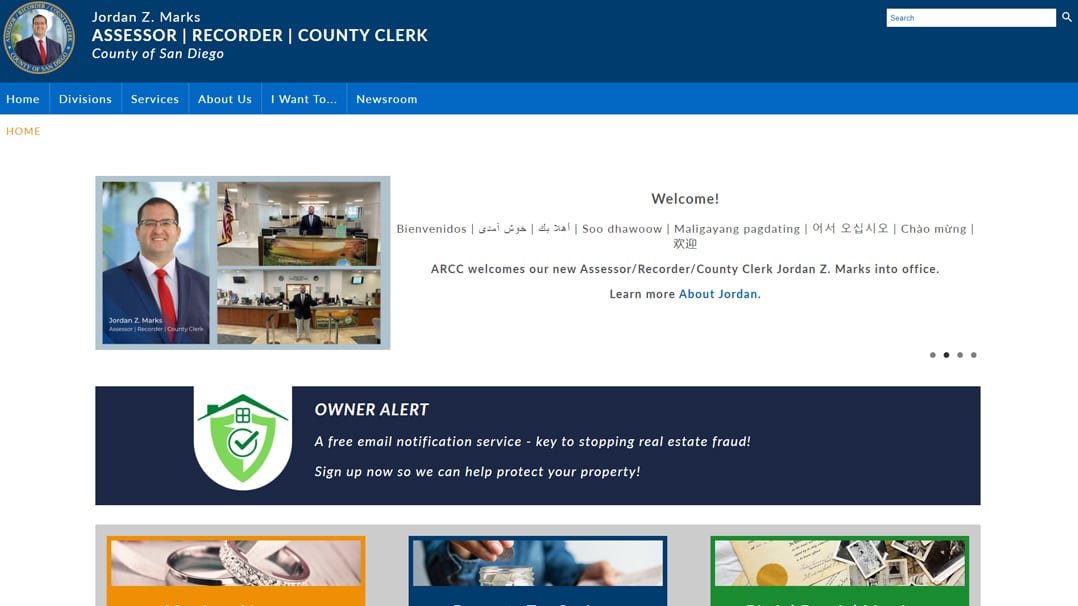
The following person in line is the San Diego County Treasurer and Tax Collector. Currently, this is Dan McAllister. Once the assessor has processed the property and its tax values, those values are sent to the SDTTC, which then prepares and issues your tax bill. The tax bill is usually mailed to you around October, and it’s due in two installments.

That’s it!
Between these two offices, all of the property taxes for the county of San Diego are handled.
If you’re considering buying property in San Diego or if you want to know what the property tax assessments are for comparable properties, there are a few resources you can access. One of which is the San Diego Prior-Year Property Tax Records.
Using this resource, you can look up the paid property taxes on a given parcel of real estate.
What Are the Tax Rates for Property in San Diego?
The property tax calculation for any given property in San Diego is pretty straightforward to calculate. All you need is a few pieces of information.
- Your property’s base assessed value. This is the value the assessor assigns to the property and is not necessarily (and frequently very far from) the market value of the property.
- The sum total of bonds in your area. Bonds (the millages mentioned above) are additions to property taxes meant to pay for things like services, public works, and local public schools. Bonds go on the ballots and are voted on.
- Mello-Roos fees and other fixed charges. These are additional charges covering things like sewer fees and other infrastructure.
What is a Mello-Roos?
As a California resident, knowing about Mello-Roos, a special tax assessment district created to finance local infrastructure and public services in our communities, is essential. The Mello-Roos Community Facilities Act of 1982 was established in response to the limitations set by Proposition 13, which capped property tax rates in California. This legislation allows local governments to create these districts in newly developed areas to fund infrastructure projects like roads, schools, parks, and police and fire protection.
When purchasing a property in California, knowing the potential Mello-Roos taxes that may apply is crucial. These taxes are in addition to regular property taxes and can vary based on the property’s size, location, and the community’s infrastructure needs. While the duration of these taxes is typically between 20-40 years, it’s essential to consider how they could impact the overall cost of homeownership. As a responsible homeowner and real estate agent, I constantly research and account for Mello-Roos taxes when evaluating a property’s affordability.
Of those pieces of information, only one remains relatively static from year to year. The other two changes are based on public works, voting results, and other influences.
The base property tax rate for properties in San Diego is 1%. That means that your base tax bill, before the assessments in #2 and #3, is 1% of the assessed value of the property. The sum total of additional assessments will vary depending on where exactly your property is located. It’s generally between .05% and .3%.
Say, for example, you purchase a real estate property in San Diego worth $1M. Since the property is changing ownership, and you don’t qualify for any of the assessment exemptions, that $1M value is the new base value for the property tax calculation. If we assume an average rate for your tax rate area – something like .15% — your total property tax rate will be 1.15%. This leaves your annual tax bill sitting at $11,500.

Critically, this is just a hypothetical example. You’ll need to know your tax rate area to determine your specific tax rate, and you’ll need to know the exact specific assessed value of your property to forecast your property tax bills accurately.
Finding Your Tax Rate Area
San Diego, both the city and the county, has hundreds of tax rate areas. You have a few options here. The first is to use this search to choose your school district. This will bring up a list of all of the tax rate areas that apply to that school district, as well as a list of all of the bonds/millages that apply to that TRA. You can then sum up and calculate the tax rate for that TRA or scroll to find the sum total on the chart.
You can use the exact search to look up TRAs by city. It’s less specific than a school district, but if you don’t know your school district, it’s the next best thing.

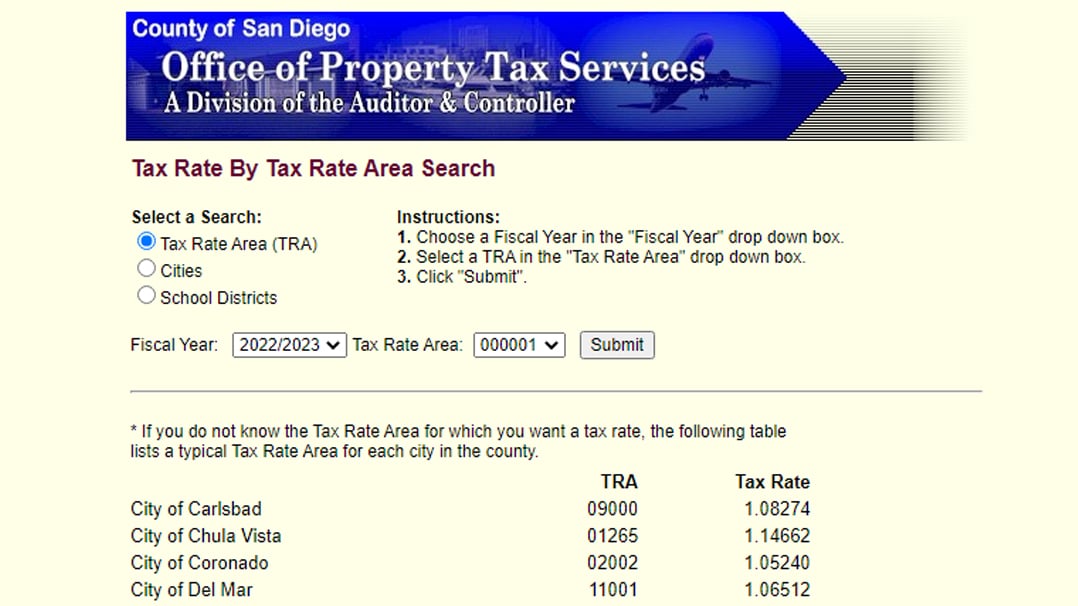
The best option, though, is to browse on a map, find the address and location of your property, and identify the tax rate area code for it. There are some pretty goofy-shaped TRAs in San Diego, so be sure to zoom in and make sure you click on the right TRA.
Once you know your TRA number, you can then look up the total tax rate on a chart like this page provided by the city. Note that the link there is for the 2019-2020 fiscal year; the values on the chart change from year to year, so you want to look up the most recent one you can.
Important Dates for San Diego Property Taxes
Property taxes in San Diego are paid in two installments, meant to soften the blow of the large single bill.

The noteworthy dates are, generally:
- October 1: The date the tax bills are mailed out to property owners.
- November 1: The date the first installment of the tax bill is due.
- December 10: The final day you can pay the first installment without a late fee or penalty.
- February 1: The date the second installment of the tax bill is due.
- April 10: The final day you can pay the second installment without a late fee or penalty.
- June 30: The last day to pay your taxes and penalties before going into default.
- July 1: If you haven’t paid by this point, you’re in default and can be levied additional charges.
If there are special circumstances, they may trigger supplemental assessments and bills, which will have their own payment schedules. Always refer to any paperwork you receive for the most relevant dates.
What are the late fees and penalties?
If you delay, forget, or misplace your tax bill and fail to pay it by the deadline, you’re subject to late fees. The penalty is 10% of the tax bill, and if you go into default, you rack up an additional 1.5% per month (or 18% per year) that is added to the total you owe.
Additionally, if you are in default for five years or longer, the treasurer/tax collector is allowed by state law to sell the property. If your property is in default, you have the right to start a five-year installment plan to bring your property out of default and redeem it.
How to Pay San Diego Property Taxes
The process of paying your property taxes is easy. You have a lot of different options.
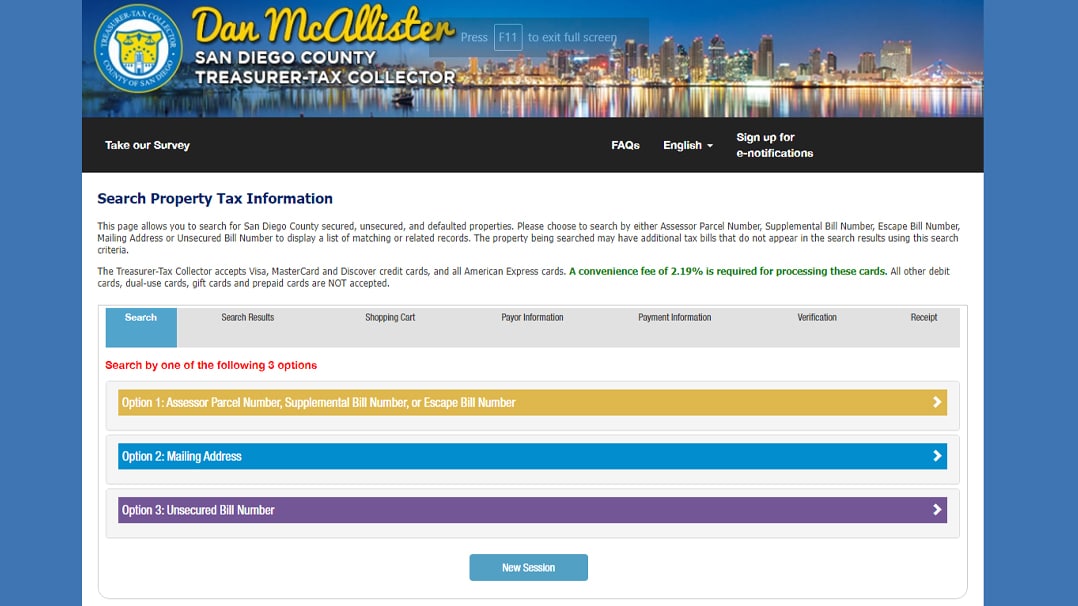
For example:
- Pay online. Online property tax payments are accepted through the web payment system found here. Look up your property and pay the associated tax bill. Note that e-check payments have no fees, but credit card payments cost an additional 2.19% as a convenience and processing fee. Debit cards are not accepted, nor are gift cards or prepaid cards.
- Pay by phone. If you have a credit card in hand, you can call the San Diego treasurer and tax collector’s office at 1-855-829-3773. You will also need information to identify the property you’re paying the bill to cover.
- Pay by mail. You can write a check and mail your payment to the treasurer/tax collector’s office. The address is below. Your payments must be postmarked on or before the date it is due, though they can arrive later with no late fee.
- Pay in person. You can visit one of the four offices of the treasurer/tax collector and write a check in person to pay your tax bills or drop a check off in a drop box if one exists. In addition to the main branch listed below, there are offices in Kearny Mesa, Chula Vista, Santee, and San Marcos.
The address for the treasurer/tax collector’s office is:
Dan McAllister
Treasurer-Tax Collector
San Diego County Admin. Center
1600 Pacific Hwy, Room 162
San Diego, CA 92101
The main office is open from 8 am to 5 pm, and the branch offices are open from 9 am to 3 pm.
Need help Handling the Tax Bills? Why Not Sell?
Property taxes can be steep, and that bill isn’t cheap to cover, but cover it you must.
If it’s reaching a point where your property – especially commercial properties, which are generally very pricey compared to residential homes – is too much to bear, you can always sell it.

Even properties that are in default can be sold as long as part of the money goes towards paying off the tax bill or the new owner accepts the liability.
If you’re interested in selling a commercial property, please reach out. I’m a practiced expert at handling commercial property transactions, and I’m always looking for people willing to sell. Contact me today, and let’s talk about what I can do for you.

Erik Egelko is a veteran of the commercial real estate business with a specialized focus on Investment Property Sales. In 2021 and 2022, Erik was the #1 ranked Broker in California for one of the largest CRE Firms as well as ranked in the Top 1% of brokers nationwide. He has extensive experience in a variety of asset types including: Retail Shopping Centers, Medical Office Buildings, Industrial Properties, and Multifamily Apartment Complexes. Over the course of his career, Erik has closed over $100,000,000 of commercial property sales throughout Southern California.



